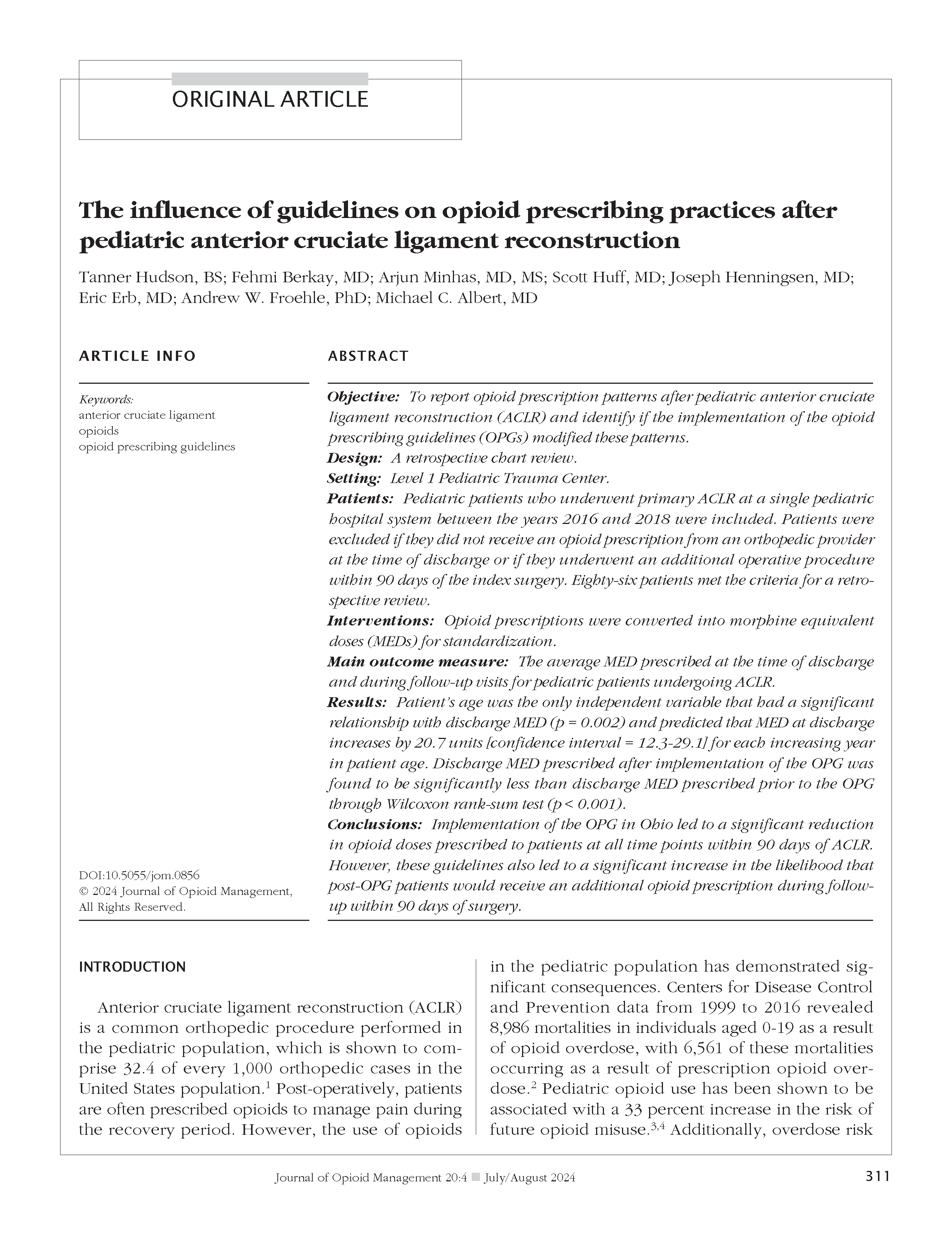The influence of guidelines on opioid prescribing practices after pediatric anterior cruciate ligament reconstruction
DOI:
https://doi.org/10.5055/jom.0856Keywords:
anterior cruciate ligament, opioids, opioid prescribing guidelinesAbstract
Objective: To report opioid prescription patterns after pediatric anterior cruciate ligament reconstruction (ACLR) and identify if the implementation of the opioid prescribing guidelines (OPGs) modified these patterns.
Design: A retrospective chart review.
Setting: Level 1 Pediatric Trauma Center.
Patients: Pediatric patients who underwent primary ACLR at a single pediatric
hospital system between the years 2016 and 2018 were included. Patients were excluded if they did not receive an opioid prescription from an orthopedic provider at the time of discharge or if they underwent an additional operative procedure within 90 days of the index surgery. Eighty-six patients met the criteria for a retrospective review.
Interventions: Opioid prescriptions were converted into morphine equivalent doses (MEDs) for standardization.
Main outcome measure: The average MED prescribed at the time of discharge and during follow-up visits for pediatric patients undergoing ACLR.
Results: Patient's age was the only independent variable that had a significant relationship with discharge MED (p = 0.002) and predicted that MED at discharge increases by 20.7 units [confidence interval = 12.3-29.1] for each increasing year in patient age. Discharge MED prescribed after implementation of the OPG was found to be significantly less than discharge MED prescribed prior to the OPG through Wilcoxon rank-sum test (p < 0.001).
Conclusions: Implementation of the OPG in Ohio led to a significant reduction in opioid doses prescribed to patients at all time points within 90 days of ACLR. However, these guidelines also led to a significant increase in the likelihood that post-OPG patients would receive an additional opioid prescription during follow-up within 90 days of surgery.
References
Tepolt FA, Feldman L, Kocher MS: Trends in pediatric ACL reconstruction from the PHIS database. J Pediatr Orthop. 2018; 38(9): e490-e494. DOI: https://doi.org/10.1097/BPO.0000000000001222
Gaither J, Shabanova V, Leventhal J: US national trends in pediatric deaths from prescription and illicit opioids, 1999-2016. JAMA Netw Open. 2018; 1(8): E186558. DOI: https://doi.org/10.1001/jamanetworkopen.2018.6558
Cazzulino A, Meza BC, Woodard T, et al.: Opioid prescriptions after pediatric orthopedic surgery: Analyzing rates of unfilled prescriptions. J Pediatr Orthop. 2021; 41(7): 457-462. DOI: https://doi.org/10.1097/BPO.0000000000001859
Meza BC, Swarup I, Woodard T, et al.: Refilling opioid prescriptions after pediatric orthopaedic surgery: An analysis of incidence and risk factors. J Pediatr Orthop. 2021; 41(3): E291-E295. DOI: https://doi.org/10.1097/BPO.0000000000001736
Groenewald C, Zhou C, Palermo T, et al.: Associations between opioid prescribing patterns and overdose among privately insured adolescents. Pediatrics. 2019; 144(5): e20184070. DOI: https://doi.org/10.1542/peds.2018-4070
Koehler R, Okoroafor U, Canada L: A systematic review of opioid use after extremity trauma in orthopedic surgery. Injury. 2018; 49(6): 1003-1007. DOI: https://doi.org/10.1016/j.injury.2018.04.003
Raney EM, Van Bosse HJP, Shea KG, et al.: Current state of the opioid epidemic as it pertains to pediatric orthopaedics from the advocacy committee of the pediatric orthopaedic society of North America. J Pediatr Orthop. 2018; 38: e238-e244. DOI: https://doi.org/10.1097/BPO.0000000000001143
Iobst C, Singh S, Yang J: Opioid prescription patterns for pediatric orthopaedic fracture patients. J Clin Orthop Trauma. 2020; 11(2): 286-290. DOI: https://doi.org/10.1016/j.jcot.2018.08.022
State Medical Board of Ohio: New limits on prescription opioids for acute pain-phase 1. 2017. Available at https://med.ohio.gov/Publications/Recent-News/new-limits-on-prescriptionopioids-for-acute-pain. Accessed March 1, 2020.
Anandarajan D, Williams BA, Markiewitz ND, et al.: Perioperative opioid exposure patterns in pediatric anterior cruciate ligament reconstruction: A ten-year administrative database study. Cureus. 2021; 13(3): e13927. DOI: https://doi.org/10.7759/cureus.13927
Karius A, Cahan EM, Segovia NA, et al.: Opiate prescribing patterns in the adolescent population following anterior cruciate ligament reconstruction. J Opioid Manag. 2021; 17(4): 321-325. DOI: https://doi.org/10.5055/jom.2021.0664
Lovecchio F, Premkumar A, Uppstrom T, et al.: Opioid consumption after arthroscopic meniscal procedures and anterior cruciate ligament reconstruction. Orthop J Sports Med. 2020; 8(4): 2325967120913549. DOI: https://doi.org/10.1177/2325967120913549
Markiewitz ND, Swarup I, Talwar D, et al.: Perioperative pain management practices vary across time and setting for pediatric ACL reconstruction: Trends from a national database in the United States. Orthop J Sports Med. 2022; 10(1): 232596712110688. DOI: https://doi.org/10.1177/23259671211068831
Mazer-Amirshahi M, Mullins PM, Rasooly IR, et al.: Trends in prescription opioid use in Pediatric Emergency Department patients. Pediatr Emerg Care. 2014; 30(4): 230-235. DOI: https://doi.org/10.1097/PEC.0000000000000102
Noble J, Zarling B, Geesey T, et al.: Analgesia use in children with acute long bone fractures in the Pediatric Emergency Department. J Emerg Med. 2020; 58(3): 500-505. DOI: https://doi.org/10.1016/j.jemermed.2019.09.018
Alexander J, Manno M: Underuse of analgesia in very young pediatric patients with isolated painful injuries. Ann Emerg Med. 2003; 41(5): 617-622. DOI: https://doi.org/10.1067/mem.2003.138
Swenson JD, Conrad KM, Pace NL, et al.: Scheduled, simultaneous dosing of pregabalin, celecoxib, and acetaminophen markedly reduces or eliminates opioid use after ACL reconstruction using allograft or hamstring tendon autograft: A randomized clinical trial. Orthop J Sports Med. 2022; 10(12): 23259671221140837. DOI: https://doi.org/10.1177/23259671221140837
Malige A, Bram JT, Maguire KJ, et al.: Decreased prescribing of postoperative opioids in pediatric ACL reconstruction: Treatment trends at a single center. Orthop J Sports Med. 2021; 9(2): 2325967120979993. DOI: https://doi.org/10.1177/2325967120979993
Maierhofer CN, Ranapurwala SI, DiPrete BL, et al.: Association between statewide opioid prescribing interventions and opioid prescribing patterns in North Carolina, 2006-2018. Pain Med. 2021; 22(12): 2931-2940. DOI: https://doi.org/10.1093/pm/pnab181

Published
How to Cite
Issue
Section
License
Copyright 2005-2025, Weston Medical Publishing, LLC and Journal of Opioid Management. All Rights Reserved.










